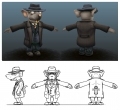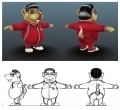Adam Marciniuk, Karolina Szablewska-Olejarz
Aidem Media
First posted on 22 January 2012. Last updated on 06 April 2012.

|
|
|

|

|

|

|

|
This interview was originally conducted in September 2011.
The authors wish to acknowledge Marcin Olejarz, Aidem Media, for his assistance.
All images are courtesy of Marcin Olejarz, Aidem Media © 2012.
Aidem Media (or AideMMedia) is a media development company in Poland and a developer of casual and adventure games for the computer and mobile platforms. City of Secrets (for which a sequel, tentatively titled City of Secrets 2, is currently in production) is the first adventure game from the developer released for the Apple iOS. The game has also been since released for the PC. It is a game in the vein of classic LucasArts adventure games but with modern graphics. In this game, you play as a mole named Moles who tries to rescue his best friend (a dog) named Rex from a strange underworld city of revolutionary moles.
We are privileged to have an opportunity to interview Karolina Szablewska-Olejarz (CEO) and Adam Marciniuk (Lead Designer) of Aidem Media. In the interview, Szablewska-Olejarz and Marciniuk discuss their inspirations to become game developers, the history behind City of Secrets, the popularity of the game's characters in Poland, the challenges of localizing the game to different languages, and whether or not they consider video games as art.
Check out our gallery of previously unpublished concept art from City of Secrets 2!
- How did you come to be a game developer?
- Karolina Szablewska-Olejarz: It all started with a passion. Games were something new and intriguing. At the same time, I knew that what the market provided was imperfect. I wanted to change it, I was boiling with ideas, I wanted to do something better and I knew that I'd find allies. I decided to act, armed with determination I gathered a strong, creative team and took a chance.
- What were your most favorite adventure games of yesteryear? Why?
- Adam Marciniuk: The list of my favorite titles is not really sophisticated. The absolute number one is of course the Neverhood. Despite obvious archaisms, it is a brilliant production that has truly endured the test of time. Subsequently, the trilogy of "Monkey Island", "Day of the Tentacle," "Blade Runner," "Grim Fandango", "Full Throttle," "Prisoner of Ice," "Broken Sword"... and many, many more. Why are those my favorites? Well, those titles introduced me to the adventure game world and made me its most avid fan. Though they were not perfect, as many mistakes, shortcomings and absurdities haunted those titles, in retrospect the only true meaning is that they gave me those long, unforgettable moments.
- How did AidemMedia come to be formed? What was the history of AidemMedia as a game development company?
- Karolina Szablewska-Olejarz: I'm a person that likes challenges, and I wanted to develop myself and have unlimited possibilities of creation. Therefore, a computer fitted like a glove. This market was only beginning to form itself, so starting a company I knew exactly what we would be making – games! At first, they were games for children as I found a synergy with the genre, but with time we broadened the scope of our work. From the start, I wanted the ability to publish our products independently and to have the freedom of operation. Our calling was always computer games and we find ourselves successful to this day. The world opens to new technologies, and so do we. And we'll never run out of ideas.
- What past game projects had AidemMedia developed prior to City of Secrets? What inspired the development of City of Secrets?
- Karolina Szablewska-Olejarz: The "City of Secrets" is not the first adventure of Rex and Moles. Their career has been turbulent and surprising. It all started with the pirate adventure in "Rex and the pirate treasure". Just when our heroes got back home, they were abducted by an UFO ("Rex and the UFO"), yet they managed to succeed with that too. In the light of their accomplishments, Rex decided that he should become a wizard and so he has done that too in "Rex and wizards". Fortunately, it didn't satisfy the brave duo's ambition. Moles and Rex decided to travel in time (in "Rex and the time machine"). They had to travel around the world until the ancient civilization of Moleons helped them to go back to their time ("Rex and captain Nemo"). "Rex and Moles in action" provided the fans with a relaxed adventure and allowed them to gain strength before the next breakneck task – our heroes stuck in the third dimension and it was necessary for the players to help them get out of those embroiled depths ("Rex and the mystery of the third dimension"). The "City of Secrets" is the newest adventure and it already has fans all over the world.
- What technical challenge did the development team face in implementing City of Secrets to run on both the PC (Windows and Mac) and the mobile (iOS) platforms?
- Karolina Szablewska-Olejarz: Implementing the "City of Secrets" for different platforms was quite easy thanks to the Unity 3D engine. We focused on creating the interface in a way that would be intuitive to both playing with a finger on iPad/iPhone and using a mouse on Mac/PC. A much greater task was creating graphics for both platforms. It had to look good and simultaneously cope with the limits of mobile devices. Sometimes we had to create separate character models, due to significant differences in devices performance. At the moment, to meet the user's expectations, we're working on a way to store game saves on a network server and to share them on all platforms. It will allow players to continue their game on any device they want.
- City of Secrets was developed using the Unity game engine. What was the development team's experience of using this engine over the course of development for City of Secrets? How different was this experience for the different platforms?
- Karolina Szablewska-Olejarz: Aidem Media have previously created games using the Unity 3D engine, but the "City of Secrets" is the largest project using that technology so far. That's why, in the beginning, we had to overcome some problems, e.g. the limits of mobile devices memory, some minor hardware differences between the iPads, iPods and iPhones of various generations. The different resolutions and sizes of the screens were another topic. As for the smaller screens, the solution was to use closer camera zoom on those devices. Using mobile devices allowed us to add the accelerometer functionality to some of the mini-games, like the trash sorting.
- How early in the development cycle was the game's music composed? How important was the music in creating the game's unique ambience?
- Adam Marciniuk: Music is more than very important. It is essential, though many people do not realize this. Bad music can ruin everything in a game. Music creates the right mood. That is why the process of composing began when the production was already sufficiently stable. The composer tried to create key locations sound environment by translating the visual effects into the language of music.
- What is the target audience for City of Secrets? To what extent does the game appeal to both younger and older adventure game fans?
- Adam Marciniuk: The game was developed and designed in such a way so the whole family can derive pleasure out of it. We tried to make it work in such a way that the adventure game veteran could feel satisfied, while a beginner would receive an intuitive system that requires no learning.
- When playing City of Secrets, the game frequently references itself as an adventure game. Why is it fitting for the game to break the fourth wall?
- Adam Marciniuk: City of Secret is a classic adventure game, which was developed for today's devices that currently occupy the market. This was our aim. We would need to ask players whether we have succeeded or not. As for breaking the "fourth wall"... well, it was a joke, because it's a lot of fun laughing at ourselves. I admit that I, myself, had a lot of laughs while writing dialogues for 'interviews with the actors', which can be viewed after the game.
- What kind of gameplay will the player expect in City of Secrets?
- Adam Marciniuk: City of Secrets is an adventure game inspired by the productions dating from the 90s of the last century. This is not a game where one needs to cut down a horde of two hundred monsters just to get a key that opens some kind of a door on the next level. We decided to make logical challenges, puzzle solving, talking to encountered characters and the practical use of objects found by the player the main fun of the game.
- What languages does City of Secrets support? What are the challenges of localizing the game to multiple languages, given that humor frequently does not survive through translation?
- Adam Marciniuk: We're preparing 9 new translations. It's a risky task because of the very specification of each language. Often something that is funny in the original version because of its sound, context or connotations, looses the effect in a different language or becomes completely senseless. For example, the main character, Moles - "Kretes" in original - is funny also because his name gives additional meaning in many situations. In polish, one can say "to lose completely" as "to loose with kretes". In our game, to lose with Moles gives new, positive feeling, it's not so utter, because we're with a friend, and that gives hope.
- There has been a long debate about whether or not video games can be considered as art. To what extent do you see yourselves as an artist? To what extent do you see City of Secret as a piece of art?
- Adam Marciniuk: We do not think of ourselves as artists. We do not consider the City of Secrets as a work of art. We are just players who tried to make as good adventure game as we could. But maybe, just maybe this is what art really is about.